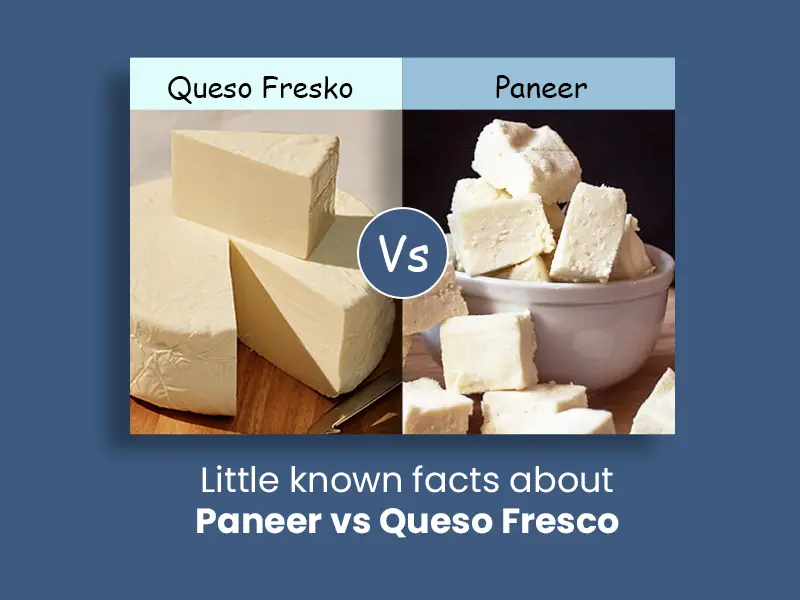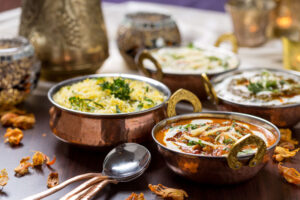Paneer cheese vs Queso Blanco – both are fresh cheese. These cheeses can be made and eaten the same day, with no need for aging or ripening. Paneer is an Indian cheese, and Queso Blanco is a Mexican cheese. However, the only difference between the two is the acid used to produce the curd.
Both paneer and queso blanco are created fresh in their home nations and are typically consumed the same day. Both curds are made with simply acid (no rennet) then pressed to remove extra whey and firm them up. They are frequently fried since they do not melt quickly. They aren’t stretched, unlike mozzarella.
This article focuses on the differences and similarities between Paneer cheese and Queso Blanco. Continue reading to learn more.
Before we start talking about the similarities and differences between these two kinds of cheese, let us first know more about them.
1. Difference Between Paneer and Queso Blanco
What Is Queso Blanco?
Queso Blanco is a light, unaged fresh Mexican cheese made from cow’s milk or a mix of cow and goat’s milk. Although “queso blanco” means “white cheese” in Spanish, similar cheeses in other places have their own names. Queso Blanco, also sometimes known as Queso Fresco (fresh cheese) due to its lack of ripening.
The cheese is incredibly easy to manufacture at home due to its short maturation process. The process is similar to that of Indian paneer, which involves boiling entire fresh milk, adding an acidifying chemical to make the curds, then straining the curds in a cheesecloth.
Queso Blanco has a mild, crisp, crumbly texture and flavor.
What is Paneer?
Paneer is a curdled Indian cheese created by heating and acidifying milk. It’s easy to make, taking only an hour or two on average, and it has the remarkable feature of not melting when heated. Here’s how to keep paneer soft.
Since paneer belongs to the category of fresh, non-melting cheeses, it’s better to use another cheese of the same type if you wish to replace it. Queso fresco, halloumi, farmer cheese, or feta cheese with the brine removed are other examples. Check out this article about the difference between paneer and feta: paneer vs feta cheese. Firm tofu cubes can also be used instead.
The following is a comparison of the two kinds of cheese in terms of texture, flavor, storage, nutrition, and calorie content.
2. Paneer cheese vs Queso Blanco: Taste and Texture
Paneer is a marble-white Indian cheese with a solid, cohesive, and spongy body, a close-knit texture, and a sweetish-acidic-nutty flavor. It has a gentle, milky flavor and a thick granular texture that complements the powerful spicy flavors found in many traditional Indian meals. You can make paneer in an instant pot at home too! And here is how to keep paneer soft.
Queso Blanco has a mild, crisp, crumbly texture and flavor. It softens but does not melt, which is a significant feature in Latin American cooking. Queso Blanco can be crumbled on salads, served over rice and beans, or served as a table cheese with fruit, toast, or chutney.
3. Paneer cheese vs Queso Blanco: Calorie Content
Paneer cheese has a higher calorie content.
At first appearance, paneer cheese appears to have slightly more calories than Queso Blanco cheese.
The difference in calories between Paneer cheese (321 kcal per 100g) and Queso Blanco cheese (310 kcal per 100g) is around 3.4%.
4. Paneer cheese vs Queso Blanco: Nutrition Facts
Have you ever wondered what nutrients paneer provides? The following are the nutritional values for paneer (100 grams).
| Nutrients | Nutritional Value |
| Protein | 18.85 grams |
| Fat | 14.7 grams |
| Energy | 257.875 Kcal |
| Folates | 93.3 micrograms |
| Carbohydrates | 12.4 grams |
| Calcium | 476 micrograms |
| Saturated Fat | 8851 micrograms |
| Monounsaturated Fat | 4300 micrograms |
| Polyunsaturated Fat | 439 micrograms |
| Phosphorus | 330 micrograms |
Paneer is a good source of protein especially for vegetarians. pic.twitter.com/zw7E63HdpP
— Sapins Dairy (@sapinsdairy) November 11, 2016
Queso Blanco
| Nutrients | Nutritional Value |
| Protein | 20 grams |
| Fat | 24 grams |
| Energy | – |
| Folates | – |
| Carbohydrates | 2.5 grams |
| Calcium | 690 micrograms |
| Saturated Fat | 14 grams |
| Monounsaturated Fat | 1.1 gram |
| Polyunsaturated Fat | 6 grams |
| Potassium | 126 micrograms |
5. Paneer cheese vs Queso Blanco: Benefits

Benefits of Paneer
1. Protein-rich Food
Cottage cheese is a substantial source of protein. It all depends on the type of milk used to make the paneer. If it’s made using full cream milk, it’s also high in fat, in addition to being a high-protein dish. Cottage cheese contains practically all important minerals, including calcium and magnesium, aside from iron.
2. Cottage Cheese Helps To Keep Bones And Teeth Strong
Cottage cheese has been one of the best calcium sources. Cottage cheese, according to experts, can provide 8% of the daily required amount. Cottage cheese provides a staggering 83 grams of protein per 100 grams! Calcium levels that are enough to ensure healthy bones, teeth, heart muscles, and neurological function.
3. Beneficial to Heart Health
Cottage cheese is also beneficial to your heart’s health. Potassium is found in paneer and is believed to have an important function in the body’s fluid equilibrium. By controlling the quantity of fluid stored in your body, your kidneys play a critical part in controlling your blood pressure. The concept is simple: the more fluid there is, the higher the pressure. Potassium not only aids in maintaining a healthy fluid balance, but also counteracts the negative effects of too much salt. However, it is necessary to ensure that the paneer is not overly salty. Cottage cheese’s high salt content can have a negative impact on your heart health.
4. Improves Digestion
Cottage cheese can help with digestion as well. Cottage cheese is high in phosphorus, which aids digestion and excretion. Cottage cheese contains magnesium, which helps to reduce constipation. Magnesium acts as a laxative. As a result, it draws water into the feces, softening them and making them easier to pass through the intestinal walls.
Benefits of Queso Blanco
1. It’s abundant in calcium and contains casein protein, as well as vitamins B12, A, and D. Queso Blanco may also help decrease blood pressure and increase mineral absorption in the digestive system.
2. It also contains omega-3 fatty acids if it is produced with organic milk. Omega-3, according to experts, can help with brain development and function, as well as enhance the immune system and lower the risk of cardiovascular disease. In comparison to aged cheeses, it is also low in salt.
6. Paneer cheese vs Queso Blanco: Storage
Paneer
The best way to keep paneer is in a water-filled container. When the paneer is soaked in water, it does not dry out and become rubbery when heated. Fresh paneer can be kept in the refrigerator for up to a week if kept in water. Replace the water every 2 to 3 days for best results.
Queso Blanco
Keep queso blanco refrigerated in its original packaging. Before opening, keep it for one to two weeks past the sell-by date. Wrap the queso blanco tightly in plastic wrap or place it in a tight-fitting reusable plastic container in the refrigerator for one to two weeks after it has been opened. If the cheese smells off or has mold growth on the top, it should be discarded altogether.
Since it is a soft cheese and soft cheeses tend to suffer when frozen, do not freeze the Queso Blanco.
7. Paneer Cheese vs Queso Blanco: Uses

Paneer
Paneer is typically chopped into cubes before being used in Indian cuisine. It can be grilled, fried, and cooked on skewers over an open flame without losing its shape because it is a non-melting cheese.
It’s commonly used in curry meals like palak paneer, which is a spinach and paneer curry, and paneer makhani, which is a tomato-based paneer curry. Cubes of paneer are deep-fried after being covered in a chickpea flour batter. Paneer tikka is produced by marinating paneer cubes in yogurt and spices, then skewering it with vegetables and grilling it in a clay oven.
Paneer absorbs the flavors of the seasonings and other spices it’s cooked with quickly due to its spongy structure. The cubes are sometimes cooked before being added to a dish, and the fried paneer is frequently held in water to keep it from drying out.
Queso Blanco
This tangy, fresh cheese is frequently used on top of saucy or spicy dishes like enchiladas, tortas, and elotes as a condiment. It can also be sprinkled over salads, tacos, soups, grilled veggies, stews, and other dishes that need a salty, sour taste boost. Fresh slices of queso blanco are sometimes offered as a side dish to rice and bean meals like gallo pinto. Queso blanco can be grilled or fried to make queso de frier since it does not melt when heated.
8. Is Paneer and Cream Cheese the same?
Paneer and cream cheese are not the same things. Though they are both made in the same way by separating cheese curds from whey, their starting points are different. While paneer is manufactured entirely of milk, Cream Cheese is made in a 1:2 milk-to-cream ratio. For more information, check out this article: Cream cheese vs paneer.
9. Is queso fresco and queso blanco the same?
Queso fresco and queso blanco are subtly different cheeses, despite their identical names, flavors, and appearances. Producers employ rennet and cultures to make the curds for queso fresco. Queso blanco is a simple cheese to make at home, using only milk and an acidifying ingredient such as lemon juice or vinegar.
Queso blanco may be suitable for a lacto-vegetarian diet, whereas rennet, which is typically produced from animals, is utilized in the manufacturing of queso fresco. However, the two words are frequently interchanged, and the cheeses are similar enough that you’d be hard-pressed to tell the difference unless you’re allergic to rennet.
Another difference between the two kinds of cheese is that Queso fresco melts very well, unlike queso blanco, which does not melt.
10. Is queso blanco a substitute for paneer?
Queso Blanco can be crumbled in salads or over other dishes due to its texture, but it can also be presented as a fresh cheese with a bowl of fresh fruits. Almost the same recipe may be used to make both queso blanco and paneer at home. As a result, they can be used interchangeably in recipes. Check out this article for everything you need to know about paneer.
11. What can I substitute for queso blanco?
- One of the best Queso Blanco substitutes is halloumi. Halloumi is a near match as a semi-hard brined cheese. This unripened blend of milk from cows, goats, and sheep produces a protein-rich cheese that is quite satisfying. Halloumi is a popular meat alternative among vegetarians because of its well-balanced nutrition.
- Another flexible Queso Blanco replacements is Indian paneer. This cheese is commonly served rolled in dough and deep-fried in India; it’s delicious with a dipping sauce.
- Quark cheese, also known as Quarg, is created from curdled milk. Quark is occasionally offered as cottage cheese, although in some places of the world, such as Germany, it is not considered cheese at all. It has a texture and flavor similar to cottage cheese. There’s no salt in it, so it’s much milder than other options, and it has a softer, less thick consistency than feta.
- Cottage cheese is the most common name for farmer’s cheese, however it is also known as ‘Farmer’s Paneer.’ Cottage cheese is one of the most popular Queso Blanco replacements. It’s basically a firmer form of traditional quark cheese, which is prepared by curdling milk and lightly salting it.










